A Generalized Logistic-Gaussian-Complex Signal Model for the Restoration of Canopy SWIR Hyperspectral Reflectance
Abstract
:1. Introduction
2. Materials and Methods
2.1. Study Site and Data Collection
2.2. The Prototype of the Logistic-Gaussian Complex Signal Modelling (LGCM) Technique
2.3. Deriving Parameters of a Generalized Logistic-Gaussian Complex Signal Model
3. Results and Discussion
3.1. A Blank Test of the Performance of the GLGCM Technique in Restoring the SWIR Signals
3.2. Sensitivity of the Generalized Parameters of Logistic Primary Signal and Gaussian Secondary Signal Sub-Models
3.3. Field Based Experimental Trials of the GLGCM Ability in Restoring of the SWIR Signals
3.4. Potential Benefits of the GLGCM Technique for Diagnosing Forest Situations and How Forest Responds to Climate Change
4. Conclusions
Funding
Acknowledgments
Conflicts of Interest
References
- Baldridge, A.M.; Hook, S.J.; Grove, C.I.; Rivera, D. The ASTER spectral library version 2.0. Remote Sens. Environ. 2009, 113, 711–715. [Google Scholar] [CrossRef]
- Hueni, A.; Nieke, J.; Schopfer, J.; Kneubühler, M.; Itten, K.I. The spectral database SPECCHIO for improved long-term usability and data sharing. Comput. Geosci. 2009, 35, 557–565. [Google Scholar] [CrossRef] [Green Version]
- Itzerott, S.; Jakimov, B.; Stichs, D.; Neumann, C.; Klinke, R. SPECTATION-Spectral Database for Vegetation. GFZ German Research Centre for Geosciences, Section 1.4, Remote Sensing. Available online: http://www.gfz-potsdam.de/sec14 (accessed on 21 March 2017).
- Clark, R.N.; Swayze, G.A.; Gallagher, A.J.; King, T.V.V.; Calvin, W.M. The U.S. Geological Survey, Digital Spectral Library Version 1: 0.2 to 3.0 Microns. U.S. Geological Survey Open File Report 93-592. 1993, p. 1326. Available online: https://pubs.usgs.gov/of/1993/0592/report.pdf (accessed on 15 May 2017).
- Fernández-Ibáñez, V.; Fearnb, T.; Soldadoa, A.; de la Roza-Delgadoa, B. Spectral library validation to identify ingredients of compound feedingstuffs by near infrared reflectance microscopy. Talanta 2009, 80, 54–60. [Google Scholar] [CrossRef] [PubMed]
- Cambule, A.H.; Rossiter, D.G.; Stoorvogel, J.J.; Smaling, E.M.A. Building a near infrared spectral library for soil organic carbon estimation in the Limpopo National Park, Mozambique. Geoderma 2012, 183–184, 41–48. [Google Scholar] [CrossRef]
- Terra, F.; Demattê, J.A.M.; Viscarra Rossel, R.A. Spectral libraries for quantitative analyses of tropical Brazilian soils: Comparing vis–NIR and mid-IR reflectance data. Geoderma 2015, 255–256, 81–93. [Google Scholar] [CrossRef]
- Guerrero, C.; Wetterlind, J.; Stenberg, B.; Mouazen, A.M.; Gabarrón-Galeote, M.A.; Ruiz-Sinoga, J.D.; Zornoza, R.; Viscarra Rossel, R.A. Do we really need large spectral libraries for local scale SOC assessment with NIR spectroscopy? Soil Tillage Res. 2016, 155, 501–509. [Google Scholar] [CrossRef]
- Ji, W.; Li, S.; Chen, S.; Shi, Z.; Viscarra Rossel, R.A.; Mouazen, A.M. Prediction of soil attributes using the Chinese soil spectral library and standardized spectra recorded at field conditions. Soil Tillage Res. 2016, 155, 492–500. [Google Scholar] [CrossRef]
- Kotthaus, S.; Smith, T.E.L.; Wooster, M.J.; Grimmond, C.S.B. Derivation of an urban materials spectral library through emittance and reflectance spectroscopy. ISPRS J. Photogramm. 2014, 94, 194–212. [Google Scholar] [CrossRef]
- Manzo, C.; Valentini, E.; Taramelli, A.; Filipponi, F.; Disperati, L. Spectral characterization of coastal sediments using FieldSpectral Libraries, Airborne Hyperspectral Images and Topographic LiDAR Data (FHyL). Int. J. Appl. Earth Obs. 2015, 36, 54–68. [Google Scholar] [CrossRef]
- Ackleson, S.G.; Moses, W.J.; Freeman, L.A. Assessing Simulated HyspIRI Imagery for Detecting and Quantifying Coral Reef Coverage and Water Quality Using Spectral Inversion and Deconvolution Methods; The 2015 HyspIRI Data Workshop; California Institute of Technology: Pasadena, CA, USA, 13–15 October 2015. [Google Scholar]
- Goswami, S.; Matharasi, K. Development of a Web-based Vegetation Spectral Library (VSL) for Remote Sensing Research and Applications. PeerJ PrePrints. 915v1. 2015. Available online: https://dx.doi.org/10.7287/peerj.preprints (accessed on 10 May 2017).
- Kokaly, R.F.; Clark, R.N.; Swayze, G.A.; Livo, K.E.; Hoefen, T.M.; Pearson, N.C.; Wise, R.A.; Benzel, W.M.; Lowers, H.A.; Driscoll, R.L.; et al. USGS Spectral Library, Version 7. 2017, p. 61. Available online: https://doi.org/10.3133/ds1035 (accessed on 15 May 2017).
- Danson, F.M.; Steven, M.D.; Malthus, T.J.; Clark, J.A. Highspectral resolution data for determining leaf water content. Int. J. Remote Sens. 1992, 13, 461–470. [Google Scholar] [CrossRef]
- Asner, G.P. Biophysical and biochemical sources of variability in canopy reflectance. Remote Sens. Environ. 1998, 64, 234–253. [Google Scholar] [CrossRef]
- Serrano, L.; Ustin, S.L.; Roberts, D.A.; Gamon, J.A. Deriving water content of chaparral vegetation from AVIRIS data. Remote Sens. Environ. 2000, 74, 570–581. [Google Scholar] [CrossRef]
- Sims, D.A.; Gamon, J.A. Relationships between leaf pigment content and spectral reflectance across a wide range of species, leaf structures and developmental stages. Remote Sens. Environ. 2002, 81, 337–354. [Google Scholar] [CrossRef]
- Clevers, J.G.P.W.; Kooistra, L.; Schaepman, M.E. Estimating canopy water content using hyperspectral remote sensing data. In Proceedings of the 9th International Conference on Precision Agriculture, Denver, CO, USA, 20–23 July 2008; ICPA: Denver, FL, USA, 2008; p. 14. [Google Scholar]
- Goetz, A.F.H. Three decades of hyperspectral remote sensing of the Earth: A personal view. Remote Sens. Environ. 2009, 113, s5–s16. [Google Scholar] [CrossRef]
- Hunt, E.R., Jr.; Rock, B.N. Detection of Changes in Leaf Water Content Using Near- and Middle-Infrared Reflectances. Remote Sens. Environ. 1989, 30, 43–54. [Google Scholar]
- Dallon, D.; Bugbee, B. Measurement of Water Stress: Comparison of Reflectance at 970 and 1450 nm; Crop Physiology Laboratory, Utah State University: Logazn, UT, USA, 2003; Available online: http://www.usu.edu/cpl/research_spectral.htm#water_stress (accessed on 12 May 2017).
- Wang, J.; Xu, R.; Yang, S. Estimation of plant water content by spectral absorption features centered at 1,450 nm and 1,940 nm regions. Environ. Monit. Assess. 2009, 157, 459–469. [Google Scholar] [CrossRef] [PubMed]
- Lin, C.; Tsogt, K.; Chang, C.I. An empirical model-based method for signal restoration of SWIR in ASD field spectroradiometry. Photogramm. Eng. Remote Sens. 2012, 78, 119–127. [Google Scholar] [CrossRef]
- Herrmann, A.K.; Bonfil, D.J.; Cohen, Y.; Alchanatis, V. SWIR-based spectral indices for assessing nitrogen content in potato fields. Int. J. Remote Sens. 2010, 37, 5127–5143. [Google Scholar] [CrossRef]
- Mahajan, G.; Pandey, R.N.; Sahoo, R.N.; Gupta, V.K.; Datta, S.C.; Kumar, D. Monitoring nitrogen, phosphorus and sulphur in hybrid rice (Oryza sativa L.) using hyperspectral remote sensing. Precis. Agric. 2017, 18, 736–761. [Google Scholar] [CrossRef]
- Camino, C.; González-Dugo, V.; Hernández, P.; Sillero, J.C.; Zarco-Tejada, P.J. Improved nitrogen retrievals with airborne-derived fluorescence and plant traits quantified from VNIR-SWIR hyperspectral imagery in the context of precision agriculture. Int. J. Appl. Earth Obs. Geoinf. 2018, 70, 105–117. [Google Scholar] [CrossRef]
- Rasti, B.; Scheunders, P.; Ghamisi, P.; Licciardi, G.; Chanussot, J. Noise reduction in hyperspectral imagery: Overview and application. Remote Sens. 2018, 10, 482. [Google Scholar] [CrossRef]
- Chatterjee, P.; Milanfar, P. Is denoising dead? IEEE Trans. Image Process. 2010, 19, 895–911. [Google Scholar] [CrossRef] [PubMed]
- Aharon, M.; Elad, M.; Bruckstein, A. K-SVD: An algorithm for designing overcomplete dictionaries for sparse representation. IEEE Trans. Signal Process. 2016, 54, 4311–4322. [Google Scholar] [CrossRef]
- Potnis, A.; Somkuwar, A.; Sapre, S.D. A review on natural image denoising using independent component analysis (ica) technique. Adv. Comput. Res. 2010, 2, 6–14. [Google Scholar]
- Ruan, C.; Zhao, D.; Jia, W.; Chen, C.; Chen, Y.; Liu, X. A new image denoising method by combining WT with ICA. Math. Probl. Eng. 2015, 2015, 582640. [Google Scholar] [CrossRef]
- Thomas, V. Hyperspectral remote sensing for forest management. In Hyperspectral Remote Sensing of Vegetation; Thenkabail, P.S., Lyon, J.G., Huete, A., Eds.; CRC Press: Boca Raton, FL, USA, 2012; pp. 469–484. [Google Scholar]
- Riaño, D.; Vaughan, P.; Chuvieco, E.; Zarco-Tejada, P.; Ustin, S.L. Estimation of fuel moisture content by inversion of radiative transfer models to simulate equivalent water thickness and dry matter content: Analysis at leaf and canopy level. IEEE Trans. Geosci. Remote Sens. 2005, 43, 819–826. [Google Scholar] [CrossRef]
- Yebra, M.; Dennison, P.E.; Chuvieco, E.; Riaño, D.; Zylstra, P.; Hunt, E.R., Jr.; Danson, F.M.; Qi, Y.; Jurdao, S. A global review of remote sensing of live fuel moisture content for fire danger assessment: Moving towards operational products. Remote Sens. Environ. 2013, 136, 455–468. [Google Scholar] [CrossRef]
- Lin, C.; Popescu, S.C.; Huang, S.C.; Chang, P.T.; Wen, H.L. A novel reflectance-based model for evaluating chlorophyll concentration of fresh and water-stressed leaves. Biogeosciences 2015, 12, 49–66. [Google Scholar] [CrossRef]
- ASD. FieldSpec Pro User’s Guide; Analytical Spectral Device Inc.: Boulder, CO, USA, 2002; pp. 27–29. [Google Scholar]
- Knaeps, E.; Dogliotti, A.L.; Raymaekers, D.; Ruddick, K.; Sterckx, S. In situ evidence of non-zero reflectance in the OLCI 1020 nm band for a turbid estuary. Remote Sens. Environ. 2012, 120, 133–144. [Google Scholar] [CrossRef]
- Lin, C.; Thomson, G.; Popescu, S.C. An IPCC-compliant technique for forest carbon stock assessment using airborne LiDAR-derived tree metrics and competition index. Remote Sens. 2016, 8, 528. [Google Scholar] [CrossRef]
- Naidoo, L.; Cho, M.A.; Mathieu, R.; Asner, G. Classification of savanna tree species, in the Greater Kruger National Park region, by integrating hyperspectral and LiDAR data in a Random Forest data mining environment. ISPRS J. Photogramm. 2012, 69, 167–179. [Google Scholar] [CrossRef]
- Lin, C.; Popescu, S.C.; Thomson, G.; Tsogt, K.; Chang, C.I. Classification of tree species in overstorey canopy of subtropical forest using QuickBird images. PLoS ONE 2015, 10, e0125554. [Google Scholar] [CrossRef] [PubMed]
- Gitelson, A.A.; Kaufman, Y.J.; Stark, R.; Rundquist, D. Novel algorithms for remote estimation of vegetation fraction. Remote Sens. Environ. 2002, 80, 76–87. [Google Scholar] [CrossRef] [Green Version]
- Lin, C.; Thomson, G.; Lo, C.S.; Yang, M.S. A multi-level morphological active contour algorithm for delineating tree crowns in mountainous forest. Photogramm. Eng. Remote Sens. 2011, 77, 241–249. [Google Scholar] [CrossRef]
- Nichol, J.E.; Sarker, M.L.R. Improved biomass estimation using the texture parameters of two high-resolution optical sensors. IEEE Trans. Geosci. Remote Sens. 2011, 49, 930–948. [Google Scholar] [CrossRef]
- Zhang, X.; Kondragunta, S.; Quayle, B. Estimation of biomass burned areas using multiple-satellite observed active fires. IEEE Trans. Geosci. Remote Sens. 2011, 49, 4469–4482. [Google Scholar] [CrossRef]
- Lo, C.S.; Lin, C. Growth-competition-based stem diameter and volume modeling for tree-level forest inventory using airborne lidar data. IEEE Trans. Geosci. Remote Sens. 2013, 51, 2216–2226. [Google Scholar] [CrossRef]
- Wagle, P.; Xiao, X.; Suyker, A.E. Estimation and analysis of gross primary production of soybean under various management practices and drought conditions. ISPRS J. Photogramm. Remote Sens. 2015, 99, 70–83. [Google Scholar] [CrossRef] [Green Version]
- Lin, C.; Dugarsuren, N. Deriving the spatiotemporal NPP pattern in terrestrial ecosystems of Mongolia using MODIS imagery. Photogram. Eng. Remote Sens. 2015, 81, 587–598. [Google Scholar] [CrossRef]
- Stöckli, R.; Rutishauser, T.; Baker, I.; Liniger, M.A.; Denning, A.S. A global reanalysis of vegetation phenology. J. Geophys. Res. Biogeosci. 2011, 116, G03020. [Google Scholar] [CrossRef]
- Lin, C.; Chen, S.Y.; Chen, C.C.; Tai, C.H. Detecting Newly Grown Tree Leaves from Unmanned-Aerial-Vehicle Images using Hyperspectral Target Detection Techniques. ISPRS J. Photogramm. Remote Sens. 2018, 142, 174–189. [Google Scholar] [CrossRef]
- Lin, C.; Wu, C.C.; Tsogt, K.; Ouyang, Y.C.; Chang, C.I. Effects of atmospheric correction and pansharpening on LULC classification accuracy using WorldView-2 imagery. Inf. Process. Agric. 2015, 2, 25–36. [Google Scholar] [CrossRef]
- Lin, C.; Tsogt, K.; Zandraabal, T. A decompositional stand structure analysis for exploring stand dynamics of multiple attributes of a mixed-species forest. For. Ecol. Manag. 2016, 378, 111–121. [Google Scholar] [CrossRef]
- Jetz, W.; Cavender-Bares, J.; Pavlick, R.; Schimel, D.; Davis, F.W.; Asner, G.P.; Guralnick, R.; Kattge, J.; Latimer, A.M.; Moorcroft, P.; et al. Monitoring plant functional diversity from space. Nat. Plants 2016, 2, 16024. [Google Scholar] [CrossRef] [PubMed] [Green Version]
- Dugarsuren, N.; Lin, C. Temporal variations in phenological events of forests, grasslands and desert steppe ecosystems in Mongolia: A remote sensing approach. Ann. For. Res. 2016, 59, 175–190. [Google Scholar]
- Chen, S.Y.; Lin, C.; Tai, C.H.; Chuang, S.J. Adaptive window-based constrained energy minimization for detection of newly grown tree leaves. Remote Sens. 2018, 10, 96. [Google Scholar] [CrossRef]
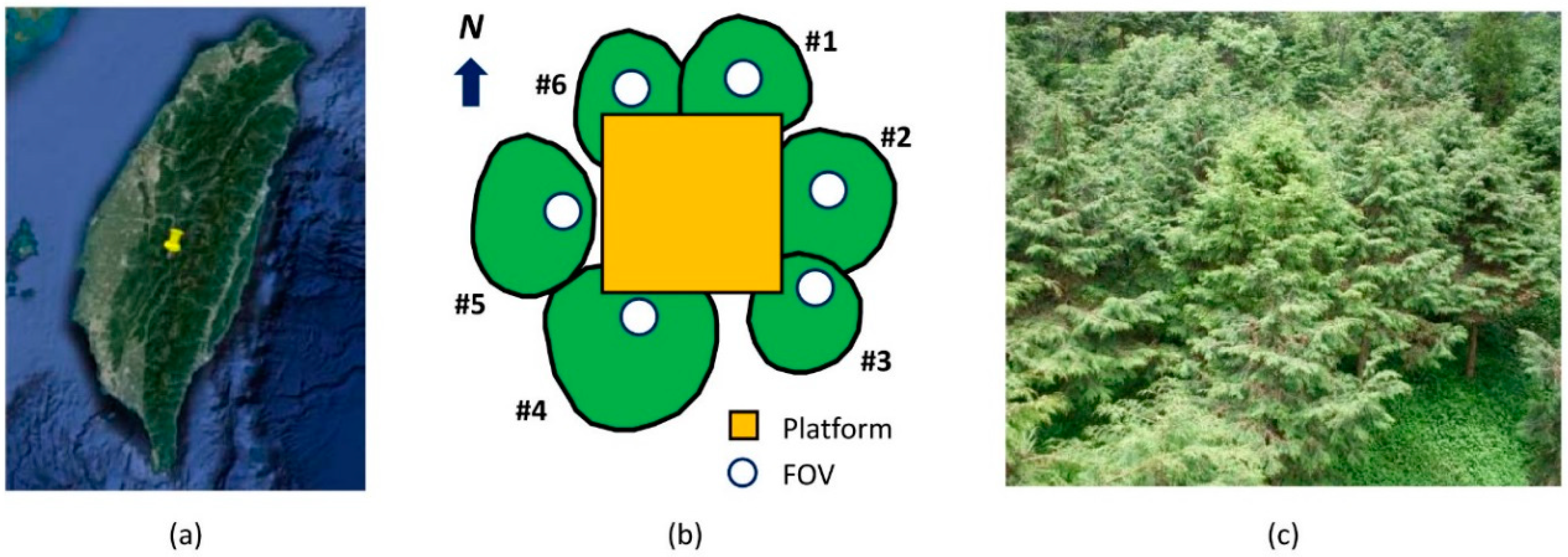
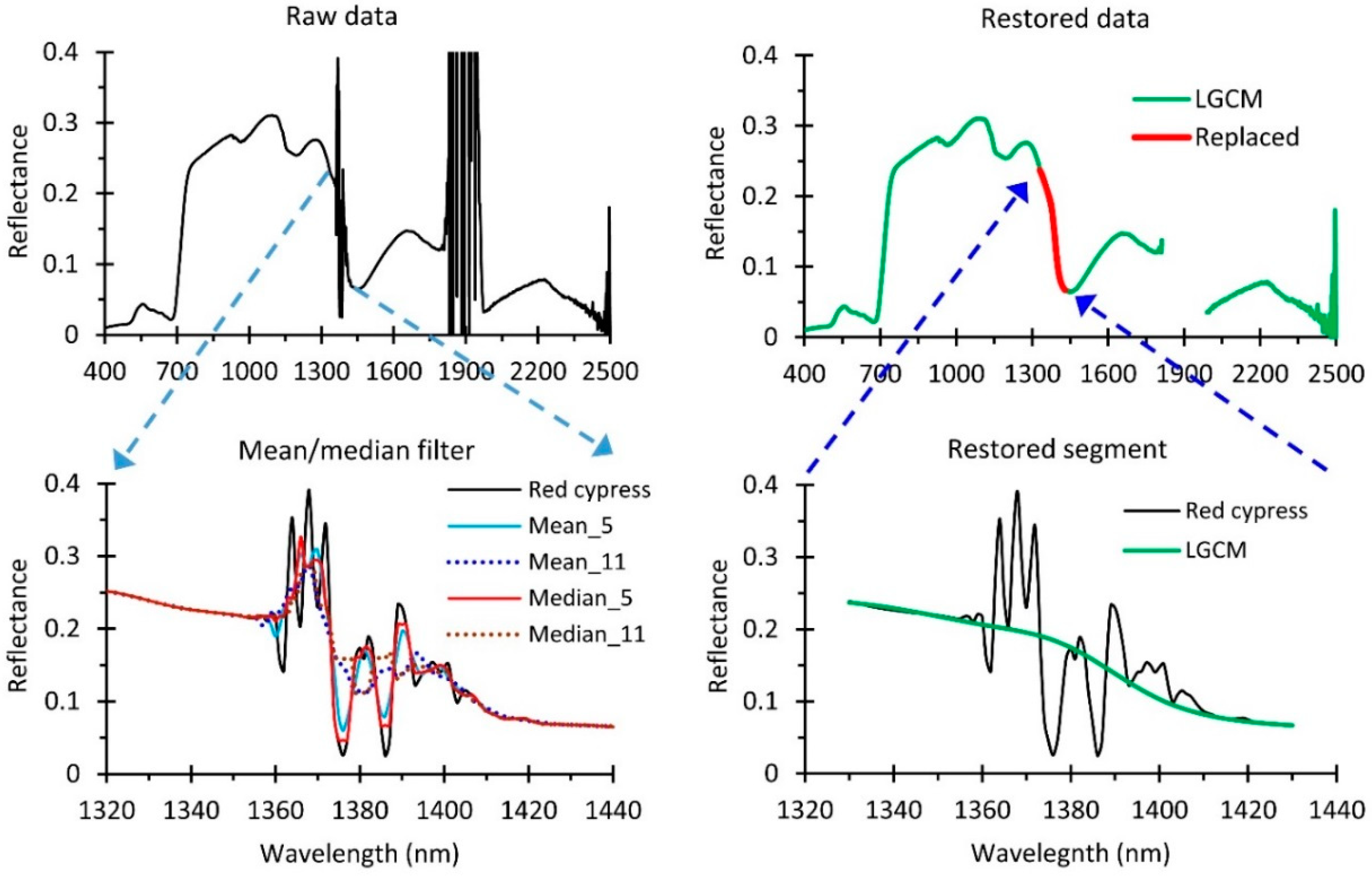
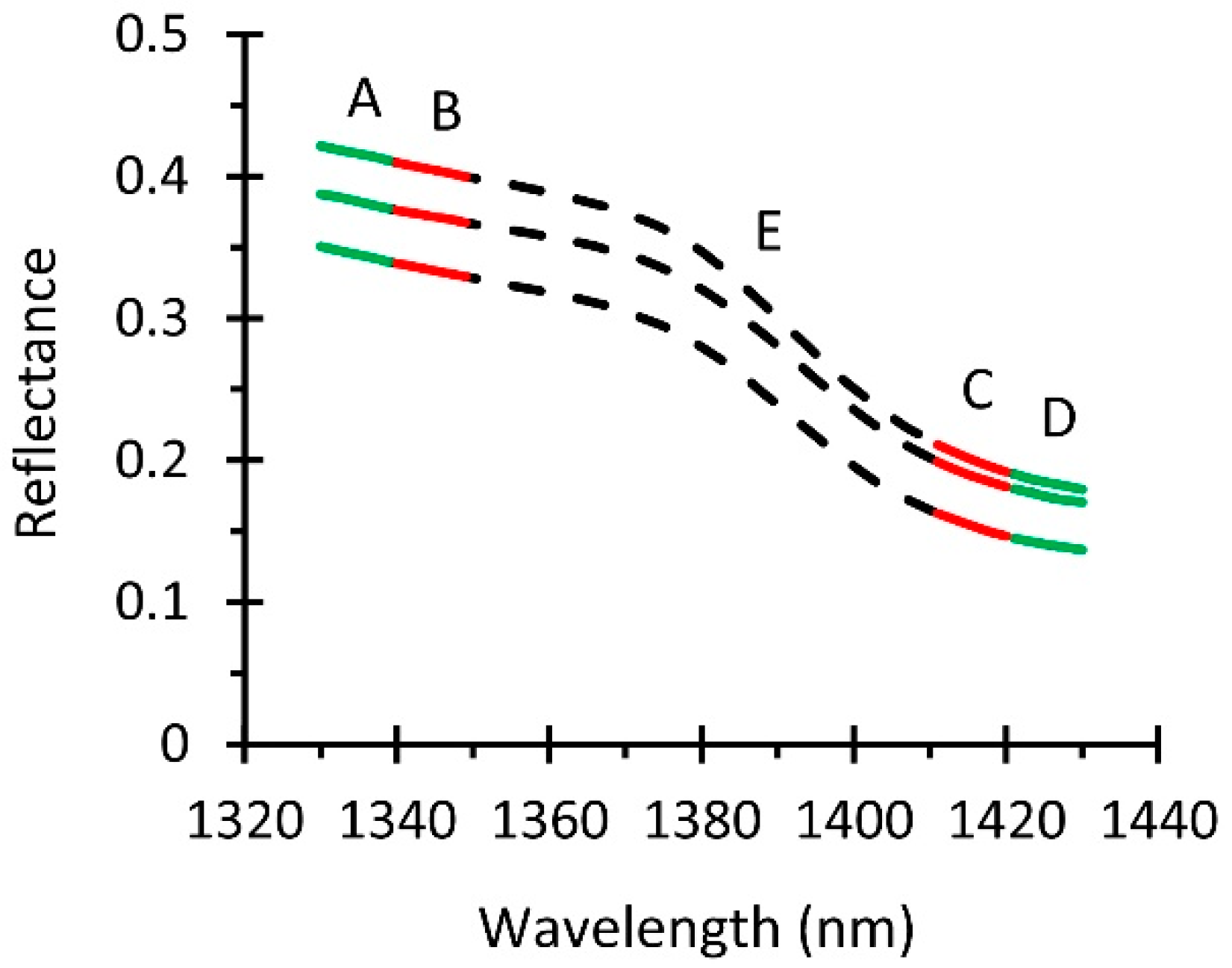
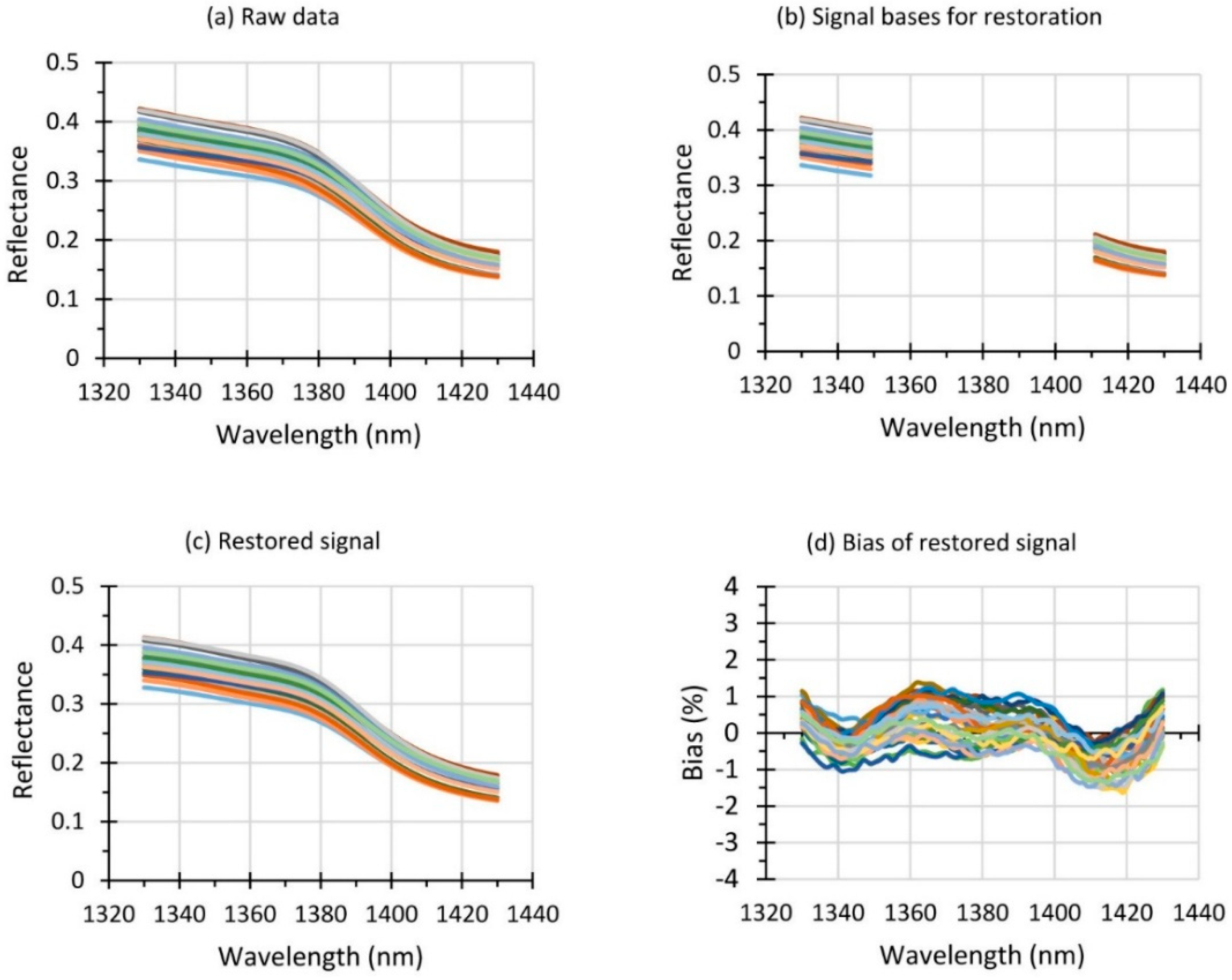

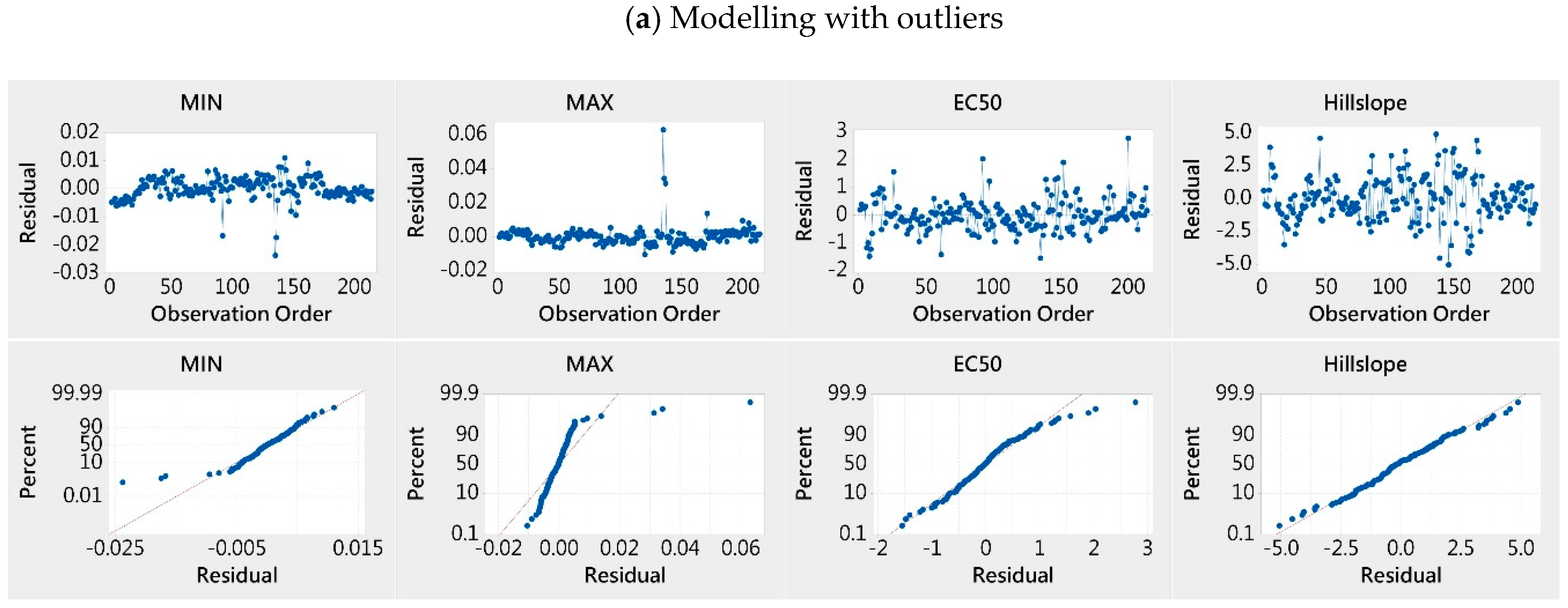

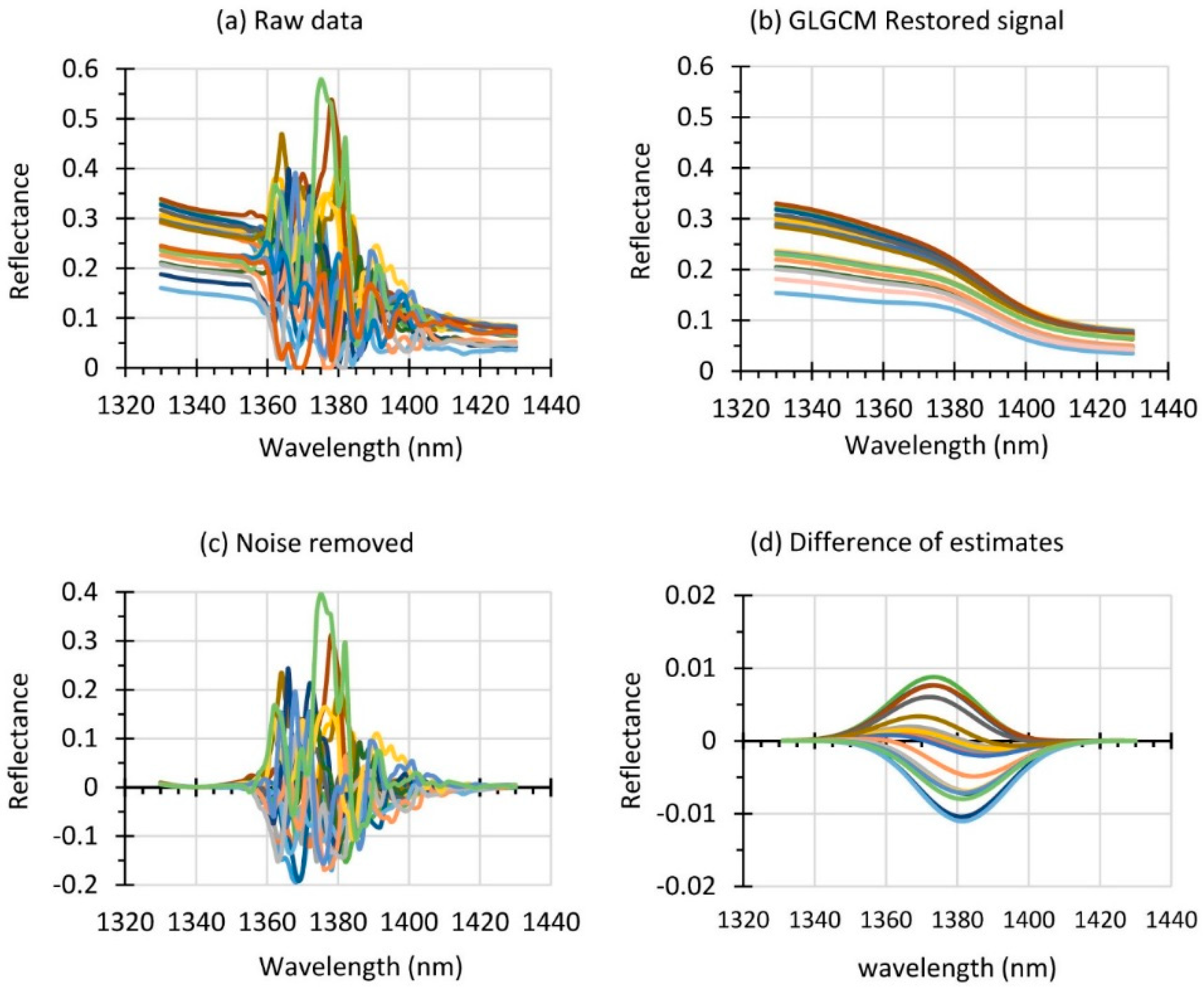
| Models | Parameters | Equations | R2 |
|---|---|---|---|
| Logistic sub-model | GMax | 0.99 | |
| GMin | 0.99 | ||
| GEC50 | 0.98 | ||
| GHillslope | 0.96 | ||
| Gaussian sub-model | Ga | 0.91 | |
| Gb | 0.04 | ||
| 0.24 |
| Structure | GMAX | GMIN | EC50/GHillslope | Ga | Gb | Gλ0 |
|---|---|---|---|---|---|---|
| 1 | A and D | A and D | A, B, C, and D | B and C | B and C | B and C |
| 2 | A and D | A and D | A, B, C, and D | B and C | x # | x |
| 3 | A and D | A and D | A, B, C, and D | x | x | x |
| 4 | A and D | A and D | x | B and C | B and C | B and C |
| 5 | A | D | A, B, C, and D | B and C | B and C | B and C |
| 6 | A | D | A, B, C, and D | x | x | x |
| 7 | A | D | x | B and C | B and C | B and C |
| 8 | A | D | x | x | x | x |
| Segments | Structure 1 | Structure 2 | Structure 3 | Structure 4 | Structure 5 | Structure 6 | Structure 7 | Structure 8 |
|---|---|---|---|---|---|---|---|---|
| Front-edge (A–B) | 0.0015 ± 0.0005 | 0.0015 ± 0.0005 | 0.0015 ± 0.0005 | 0.0050 ± 0.0009 | 0.0058 ± 0.0014 | 0.0058 ± 0.0015 | 0.0108 ± 0.0008 | 0.0108 ± 0.0009 |
| End-edge (C–D) | 0.0011 ± 0.0005 | 0.0010 ± 0.0005 | 0.0011 ± 0.0005 | 0.0187 ± 0.0016 | 0.0013 ± 0.0008 | 0.0013 ± 0.0008 | 0.0191 ± 0.0014 | 0.0192 ± 0.0014 |
| Central (E) | 0.0014 ± 0.0006 | 0.0015 ± 0.0007 | 0.0026 ± 0.0012 | 0.0309 ± 0.0031 | 0.0045 ± 0.0013 | 0.0034 ± 0.0013 | 0.0335 ± 0.0026 | 0.0315 ± 0.0033 |
| GLGCM Models | Parameters † | Equations | R2 |
|---|---|---|---|
| Logistic sub-model | GMax | 0.99 | |
| GMin | 0.97 | ||
| GEC50 | 0.93 | ||
| GHillslope | 0.93 | ||
| Gaussian sub-model | (#1) | Ga, Gb, and Gλ0 | - |
| Gaussian sub-model | (#2) | - |
© 2018 by the author. Licensee MDPI, Basel, Switzerland. This article is an open access article distributed under the terms and conditions of the Creative Commons Attribution (CC BY) license (http://creativecommons.org/licenses/by/4.0/).
Share and Cite
Lin, C. A Generalized Logistic-Gaussian-Complex Signal Model for the Restoration of Canopy SWIR Hyperspectral Reflectance. Remote Sens. 2018, 10, 1062. https://doi.org/10.3390/rs10071062
Lin C. A Generalized Logistic-Gaussian-Complex Signal Model for the Restoration of Canopy SWIR Hyperspectral Reflectance. Remote Sensing. 2018; 10(7):1062. https://doi.org/10.3390/rs10071062
Chicago/Turabian StyleLin, Chinsu. 2018. "A Generalized Logistic-Gaussian-Complex Signal Model for the Restoration of Canopy SWIR Hyperspectral Reflectance" Remote Sensing 10, no. 7: 1062. https://doi.org/10.3390/rs10071062






